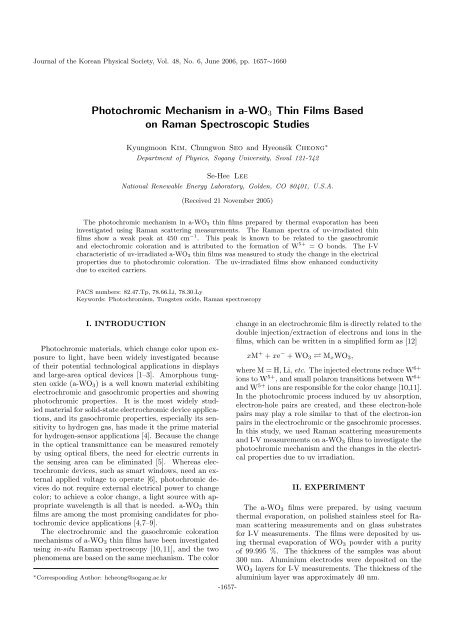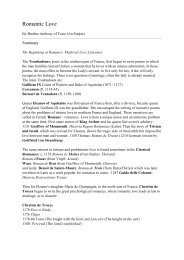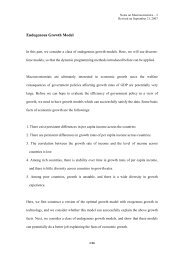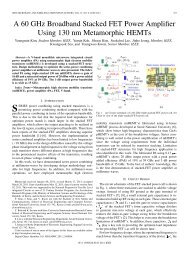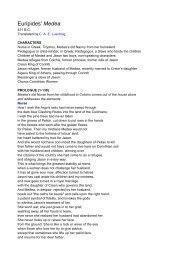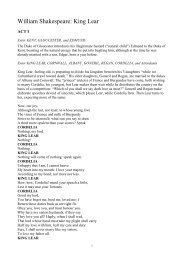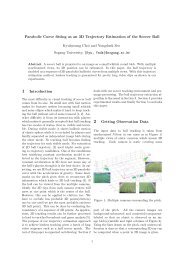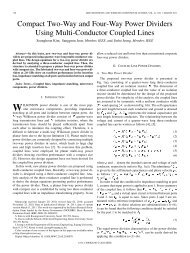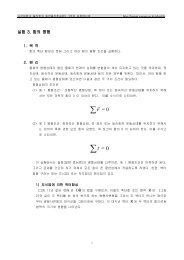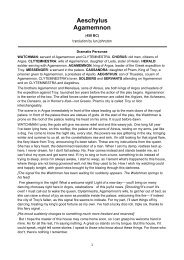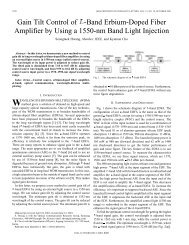Photochromic Mechanism in a-WO3 Thin Films Based on Raman ...
Photochromic Mechanism in a-WO3 Thin Films Based on Raman ...
Photochromic Mechanism in a-WO3 Thin Films Based on Raman ...
Create successful ePaper yourself
Turn your PDF publications into a flip-book with our unique Google optimized e-Paper software.
Journal of the Korean Physical Society, Vol. 48, No. 6, June 2006, pp. 1657∼1660<br />
<str<strong>on</strong>g>Photochromic</str<strong>on</strong>g> <str<strong>on</strong>g>Mechanism</str<strong>on</strong>g> <str<strong>on</strong>g>in</str<strong>on</strong>g> a-WO 3 Th<str<strong>on</strong>g>in</str<strong>on</strong>g> <str<strong>on</strong>g>Films</str<strong>on</strong>g> <str<strong>on</strong>g>Based</str<strong>on</strong>g><br />
<strong>on</strong> <strong>Raman</strong> Spectroscopic Studies<br />
Kyungmo<strong>on</strong> Kim, Chungw<strong>on</strong> Seo and Hye<strong>on</strong>sik Che<strong>on</strong>g ∗<br />
Department of Physics, Sogang University, Seoul 121-742<br />
Se-Hee Lee<br />
Nati<strong>on</strong>al Renewable Energy Laboratory, Golden, CO 80401, U.S.A.<br />
(Received 21 November 2005)<br />
The photochromic mechanism <str<strong>on</strong>g>in</str<strong>on</strong>g> a-WO 3 th<str<strong>on</strong>g>in</str<strong>on</strong>g> films prepared by thermal evaporati<strong>on</strong> has been<br />
<str<strong>on</strong>g>in</str<strong>on</strong>g>vestigated us<str<strong>on</strong>g>in</str<strong>on</strong>g>g <strong>Raman</strong> scatter<str<strong>on</strong>g>in</str<strong>on</strong>g>g measurements. The <strong>Raman</strong> spectra of uv-irradiated th<str<strong>on</strong>g>in</str<strong>on</strong>g><br />
films show a weak peak at 450 cm −1 . This peak is known to be related to the gasochromic<br />
and electochromic colorati<strong>on</strong> and is attributed to the formati<strong>on</strong> of W 5+ = O b<strong>on</strong>ds. The I-V<br />
characteristic of uv-irradiated a-WO 3 th<str<strong>on</strong>g>in</str<strong>on</strong>g> films was measured to study the change <str<strong>on</strong>g>in</str<strong>on</strong>g> the electrical<br />
properties due to photochromic colorati<strong>on</strong>. The uv-irradiated films show enhanced c<strong>on</strong>ductivity<br />
due to excited carriers.<br />
PACS numbers: 82.47.Tp, 78.66.Li, 78.30.Ly<br />
Keywords: Photochromism, Tungsten oxide, <strong>Raman</strong> spectroscopy<br />
I. INTRODUCTION<br />
<str<strong>on</strong>g>Photochromic</str<strong>on</strong>g> materials, which change color up<strong>on</strong> exposure<br />
to light, have been widely <str<strong>on</strong>g>in</str<strong>on</strong>g>vestigated because<br />
of their potential technological applicati<strong>on</strong>s <str<strong>on</strong>g>in</str<strong>on</strong>g> displays<br />
and large-area optical devices [1–3]. Amorphous tungsten<br />
oxide (a-WO 3 ) is a well known material exhibit<str<strong>on</strong>g>in</str<strong>on</strong>g>g<br />
electrochromic and gasochromic properties and show<str<strong>on</strong>g>in</str<strong>on</strong>g>g<br />
photochromic properties. It is the most widely studied<br />
material for solid-state electrochromic device applicati<strong>on</strong>s,<br />
and its gasochromic properties, especially its sensitivity<br />
to hydrogen gas, has made it the prime material<br />
for hydrogen-sensor applicati<strong>on</strong>s [4]. Because the change<br />
<str<strong>on</strong>g>in</str<strong>on</strong>g> the optical transmittance can be measured remotely<br />
by us<str<strong>on</strong>g>in</str<strong>on</strong>g>g optical fibers, the need for electric currents <str<strong>on</strong>g>in</str<strong>on</strong>g><br />
the sens<str<strong>on</strong>g>in</str<strong>on</strong>g>g area can be elim<str<strong>on</strong>g>in</str<strong>on</strong>g>ated [5]. Whereas electrochromic<br />
devices, such as smart w<str<strong>on</strong>g>in</str<strong>on</strong>g>dows, need an external<br />
applied voltage to operate [6], photochromic devices<br />
do not require external electrical power to change<br />
color; to achieve a color change, a light source with appropriate<br />
wavelength is all that is needed. a-WO 3 th<str<strong>on</strong>g>in</str<strong>on</strong>g><br />
films are am<strong>on</strong>g the most promis<str<strong>on</strong>g>in</str<strong>on</strong>g>g candidates for photochromic<br />
device applicati<strong>on</strong>s [4,7–9].<br />
The electrochromic and the gasochromic colorati<strong>on</strong><br />
mechanisms of a-WO 3 th<str<strong>on</strong>g>in</str<strong>on</strong>g> films have been <str<strong>on</strong>g>in</str<strong>on</strong>g>vestigated<br />
us<str<strong>on</strong>g>in</str<strong>on</strong>g>g <str<strong>on</strong>g>in</str<strong>on</strong>g>-situ <strong>Raman</strong> spectroscopy [10,11], and the two<br />
phenomena are based <strong>on</strong> the same mechanism. The color<br />
∗ Corresp<strong>on</strong>d<str<strong>on</strong>g>in</str<strong>on</strong>g>g Author: hche<strong>on</strong>g@sogang.ac.kr<br />
change <str<strong>on</strong>g>in</str<strong>on</strong>g> an electrochromic film is directly related to the<br />
double <str<strong>on</strong>g>in</str<strong>on</strong>g>jecti<strong>on</strong>/extracti<strong>on</strong> of electr<strong>on</strong>s and i<strong>on</strong>s <str<strong>on</strong>g>in</str<strong>on</strong>g> the<br />
films, which can be written <str<strong>on</strong>g>in</str<strong>on</strong>g> a simplified form as [12]<br />
xM + + xe − + WO 3 ⇄ M x WO 3 ,<br />
where M = H, Li, etc. The <str<strong>on</strong>g>in</str<strong>on</strong>g>jected electr<strong>on</strong>s reduce W 6+<br />
i<strong>on</strong>s to W 5+ , and small polar<strong>on</strong> transiti<strong>on</strong>s between W 6+<br />
and W 5+ i<strong>on</strong>s are resp<strong>on</strong>sible for the color change [10,11].<br />
In the photochromic process <str<strong>on</strong>g>in</str<strong>on</strong>g>duced by uv absorpti<strong>on</strong>,<br />
electr<strong>on</strong>-hole pairs are created, and these electr<strong>on</strong>-hole<br />
pairs may play a role similar to that of the electr<strong>on</strong>-i<strong>on</strong><br />
pairs <str<strong>on</strong>g>in</str<strong>on</strong>g> the electrochromic or the gasochromic processes.<br />
In this study, we used <strong>Raman</strong> scatter<str<strong>on</strong>g>in</str<strong>on</strong>g>g measurements<br />
and I-V measurements <strong>on</strong> a-WO 3 films to <str<strong>on</strong>g>in</str<strong>on</strong>g>vestigate the<br />
photochromic mechanism and the changes <str<strong>on</strong>g>in</str<strong>on</strong>g> the electrical<br />
properties due to uv irradiati<strong>on</strong>.<br />
II. EXPERIMENT<br />
The a-WO 3 films were prepared, by us<str<strong>on</strong>g>in</str<strong>on</strong>g>g vacuum<br />
thermal evaporati<strong>on</strong>, <strong>on</strong> polished sta<str<strong>on</strong>g>in</str<strong>on</strong>g>less steel for <strong>Raman</strong><br />
scatter<str<strong>on</strong>g>in</str<strong>on</strong>g>g measurements and <strong>on</strong> glass substrates<br />
for I-V measurements. The films were deposited by us<str<strong>on</strong>g>in</str<strong>on</strong>g>g<br />
thermal evaporati<strong>on</strong> of WO 3 powder with a purity<br />
of 99.995 %. The thickness of the samples was about<br />
300 nm. Alum<str<strong>on</strong>g>in</str<strong>on</strong>g>ium electrodes were deposited <strong>on</strong> the<br />
WO 3 layers for I-V measurements. The thickness of the<br />
alum<str<strong>on</strong>g>in</str<strong>on</strong>g>ium layer was approximately 40 nm.<br />
-1657-
-1658- Journal of the Korean Physical Society, Vol. 48, No. 6, June 2006<br />
Fig. 1. <strong>Raman</strong> spectroscopy setup for the photochoromism<br />
study.<br />
Figure 1 shows the <strong>Raman</strong> spectroscopy setup used <str<strong>on</strong>g>in</str<strong>on</strong>g><br />
this study. The <strong>Raman</strong> spectra were taken <str<strong>on</strong>g>in</str<strong>on</strong>g> the quasibackscatter<str<strong>on</strong>g>in</str<strong>on</strong>g>g<br />
geometry us<str<strong>on</strong>g>in</str<strong>on</strong>g>g the 514.5-nm l<str<strong>on</strong>g>in</str<strong>on</strong>g>e of an Ar<br />
i<strong>on</strong> laser with 50 mw focused to a l<str<strong>on</strong>g>in</str<strong>on</strong>g>e of 5 mm × 100 µm<br />
as the excitati<strong>on</strong> source. The scattered light was filtered<br />
with a holographic edge filter, dispersed by a Spex 0.55-m<br />
spectrometer, and detected with a liquid-nitrogen-cooled<br />
back-illum<str<strong>on</strong>g>in</str<strong>on</strong>g>ated charge-coupled-device (CCD) detector<br />
array. Both the spectral resoluti<strong>on</strong> and the accuracy <str<strong>on</strong>g>in</str<strong>on</strong>g><br />
the <strong>Raman</strong> shift are estimated to be 2 cm −1 . As the<br />
uv source, the 325-nm l<str<strong>on</strong>g>in</str<strong>on</strong>g>e of a He-Cd laser with about<br />
4 mW was used. The two laser beams are aligned to<br />
be col<str<strong>on</strong>g>in</str<strong>on</strong>g>ear as they enter the focus<str<strong>on</strong>g>in</str<strong>on</strong>g>g cyl<str<strong>on</strong>g>in</str<strong>on</strong>g>drical lens.<br />
This ensures that the <strong>Raman</strong> spectrum is measured from<br />
the same spot as that subjected to the uv irradiati<strong>on</strong>.<br />
The <strong>Raman</strong> spectra were measured before and after uv<br />
irradiati<strong>on</strong>.<br />
I-V measurements were carried out us<str<strong>on</strong>g>in</str<strong>on</strong>g>g a Stanford<br />
Research Systems model PS325 high-voltage power supply<br />
and an Agilent 34410A digital multimeter. The samples<br />
for the I-V measurements had alum<str<strong>on</strong>g>in</str<strong>on</strong>g>ium electrodes,<br />
and the gap between them was about 1 mm. The I-V<br />
curves were measured before, after, and dur<str<strong>on</strong>g>in</str<strong>on</strong>g>g uv irradiati<strong>on</strong>.<br />
III. RESULTS AND DISCUSSION<br />
Figure 2 shows the <strong>Raman</strong> spectra for evaporated a-<br />
WO 3 films irradiated with uv light for different time durati<strong>on</strong>s:<br />
(a) 0 sec (as-deposited), (b) 30 sec, (c) 1 m<str<strong>on</strong>g>in</str<strong>on</strong>g>,<br />
(d) 2 m<str<strong>on</strong>g>in</str<strong>on</strong>g>, (e) 5 m<str<strong>on</strong>g>in</str<strong>on</strong>g>, (f) 10 m<str<strong>on</strong>g>in</str<strong>on</strong>g>, (g) 20 m<str<strong>on</strong>g>in</str<strong>on</strong>g>, (h) 30 m<str<strong>on</strong>g>in</str<strong>on</strong>g>,<br />
and (i) 60 m<str<strong>on</strong>g>in</str<strong>on</strong>g>. The spectrum of the as-deposited film<br />
(a) shows a broad peak at 770 cm −1 due to the W 6+ −O<br />
s<str<strong>on</strong>g>in</str<strong>on</strong>g>gle b<strong>on</strong>ds. There is also a relatively sharp peak at 950<br />
cm −1 , which has been assigned to the stretch<str<strong>on</strong>g>in</str<strong>on</strong>g>g mode<br />
of the W 6+ = O double b<strong>on</strong>ds <str<strong>on</strong>g>in</str<strong>on</strong>g>volv<str<strong>on</strong>g>in</str<strong>on</strong>g>g term<str<strong>on</strong>g>in</str<strong>on</strong>g>al oxygen<br />
Fig. 2. <strong>Raman</strong> spectra of a-WO 3 films measured after uv<br />
irradiati<strong>on</strong>. The durati<strong>on</strong>s of the uv irradiati<strong>on</strong> are (a) 0 sec<br />
(as-deposited), (b) 30 sec, (c) 1 m<str<strong>on</strong>g>in</str<strong>on</strong>g>, (d) 2 m<str<strong>on</strong>g>in</str<strong>on</strong>g>, (e) 5 m<str<strong>on</strong>g>in</str<strong>on</strong>g>, (f)<br />
10 m<str<strong>on</strong>g>in</str<strong>on</strong>g>, (g) 20 m<str<strong>on</strong>g>in</str<strong>on</strong>g>, (h) 30 m<str<strong>on</strong>g>in</str<strong>on</strong>g>, and (i) 60 m<str<strong>on</strong>g>in</str<strong>on</strong>g>.<br />
Fig. 3. Detailed comparis<strong>on</strong> of <strong>Raman</strong> spectra of a-WO 3<br />
films before and after uv irradiati<strong>on</strong>. The arrow <str<strong>on</strong>g>in</str<strong>on</strong>g>dicates the<br />
450 cm −1 peak related to W 5+ = O b<strong>on</strong>ds.<br />
atoms <strong>on</strong> the surfaces of clusters and microvoid structures<br />
<str<strong>on</strong>g>in</str<strong>on</strong>g> the film [10,13–16].<br />
Figure 3 compares the <strong>Raman</strong> spectra taken before<br />
and after an uv irradiati<strong>on</strong> of 60 m<str<strong>on</strong>g>in</str<strong>on</strong>g>. The <strong>Raman</strong> spectrum<br />
of the uv-irradiated film shows a peak at 450 cm −1 .<br />
This peak also appears <str<strong>on</strong>g>in</str<strong>on</strong>g> electrochromic or gasochromic<br />
colorati<strong>on</strong> of a-WO 3 th<str<strong>on</strong>g>in</str<strong>on</strong>g> films and has been attributed<br />
to W 5+ = O double b<strong>on</strong>ds [10,15,16] formed by reducti<strong>on</strong><br />
of W 6+ = O as electr<strong>on</strong>s are <str<strong>on</strong>g>in</str<strong>on</strong>g>serted [16,17].<br />
With uv irradiati<strong>on</strong>, the overall <str<strong>on</strong>g>in</str<strong>on</strong>g>tensities of the two<br />
ma<str<strong>on</strong>g>in</str<strong>on</strong>g> <strong>Raman</strong> peaks decrease due to the reducti<strong>on</strong> of W 6+<br />
i<strong>on</strong>s to W 5+ i<strong>on</strong>s. The <strong>Raman</strong> <str<strong>on</strong>g>in</str<strong>on</strong>g>tensities of W 6+ −O and<br />
W 6+ = O b<strong>on</strong>ds, and the ratio of the <str<strong>on</strong>g>in</str<strong>on</strong>g>tegrated <str<strong>on</strong>g>in</str<strong>on</strong>g>tensity<br />
of the W 6+ = O b<strong>on</strong>d peak at 950 cm −1 to that of<br />
the O-W 6+ −O peak at 770 cm −1 are plotted <str<strong>on</strong>g>in</str<strong>on</strong>g> Figure<br />
4. The data show that with uv irradiati<strong>on</strong>, the W 6+ =<br />
O/W 6+ −O ratio <str<strong>on</strong>g>in</str<strong>on</strong>g>creases. The <str<strong>on</strong>g>in</str<strong>on</strong>g>crease <str<strong>on</strong>g>in</str<strong>on</strong>g> the W 6+ =
<str<strong>on</strong>g>Photochromic</str<strong>on</strong>g> <str<strong>on</strong>g>Mechanism</str<strong>on</strong>g> <str<strong>on</strong>g>in</str<strong>on</strong>g> a-WO 3 Th<str<strong>on</strong>g>in</str<strong>on</strong>g> <str<strong>on</strong>g>Films</str<strong>on</strong>g>· · · – Kyungmo<strong>on</strong> Kim et al. -1659-<br />
Fig. 4. <strong>Raman</strong> <str<strong>on</strong>g>in</str<strong>on</strong>g>tensities of the W 6+ −O and the W 6+ =<br />
O b<strong>on</strong>ds and the ratio W 6+ = O/W 6+ −O as functi<strong>on</strong>s of the<br />
uv irradiati<strong>on</strong> time.<br />
O/W 6+ −O ratio <str<strong>on</strong>g>in</str<strong>on</strong>g> the <strong>Raman</strong> spectrum of uv-irradiated<br />
a-WO 3 is similar to what is observed <str<strong>on</strong>g>in</str<strong>on</strong>g> electrochemical<br />
<str<strong>on</strong>g>in</str<strong>on</strong>g>tercalati<strong>on</strong> of Li <str<strong>on</strong>g>in</str<strong>on</strong>g>to a-WO 3 . For Li c<strong>on</strong>centrati<strong>on</strong> x<br />
up to x = 0.05 <str<strong>on</strong>g>in</str<strong>on</strong>g> a-Li x WO 3 , this ratio <str<strong>on</strong>g>in</str<strong>on</strong>g>creases m<strong>on</strong>ot<strong>on</strong>ically<br />
[11,18]. This <str<strong>on</strong>g>in</str<strong>on</strong>g>dicates that electr<strong>on</strong>s have c<strong>on</strong>verted<br />
more W 6+ <str<strong>on</strong>g>in</str<strong>on</strong>g>to W 5+ <str<strong>on</strong>g>in</str<strong>on</strong>g> W 6+ −O sites than <str<strong>on</strong>g>in</str<strong>on</strong>g> W 6+<br />
= O sites [11]. Unlike Li <str<strong>on</strong>g>in</str<strong>on</strong>g>tercalati<strong>on</strong>, however, the <strong>Raman</strong><br />
spectra of uv-irradiated a-WO 3 do not show the<br />
peak due to W 5+ −O b<strong>on</strong>ds [10]. This is probably due<br />
to the fact that the degree of colorati<strong>on</strong> <str<strong>on</strong>g>in</str<strong>on</strong>g> the current<br />
photochromic experiment is lower than that <str<strong>on</strong>g>in</str<strong>on</strong>g> Li <str<strong>on</strong>g>in</str<strong>on</strong>g>tercalati<strong>on</strong><br />
experiments. In fact, the aforementi<strong>on</strong>ed <str<strong>on</strong>g>in</str<strong>on</strong>g>crease<br />
<str<strong>on</strong>g>in</str<strong>on</strong>g> the W 6+ = O/W 6+ −O ratio corresp<strong>on</strong>ds to the low<br />
Li-c<strong>on</strong>centrati<strong>on</strong> regi<strong>on</strong> <str<strong>on</strong>g>in</str<strong>on</strong>g> electrochemical <str<strong>on</strong>g>in</str<strong>on</strong>g>tercalati<strong>on</strong><br />
[11]. For low Li c<strong>on</strong>centrati<strong>on</strong>s, the <strong>Raman</strong> peak due to<br />
W 5+ −O b<strong>on</strong>ds is difficult to resolve because of its large<br />
l<str<strong>on</strong>g>in</str<strong>on</strong>g>ewidth. The band-gap energy of a-WO 3 is 3.25 eV<br />
[1]. With uv irradiati<strong>on</strong>, optically exited electr<strong>on</strong>-hole<br />
pairs are created <str<strong>on</strong>g>in</str<strong>on</strong>g> a-WO 3 . The electr<strong>on</strong>s reduce W 6+<br />
i<strong>on</strong>s to W 5+ i<strong>on</strong>s, result<str<strong>on</strong>g>in</str<strong>on</strong>g>g <str<strong>on</strong>g>in</str<strong>on</strong>g> colorati<strong>on</strong> of the film. The<br />
role of photo-excited holes is not clear. A model suggests<br />
that holes decompose the water <str<strong>on</strong>g>in</str<strong>on</strong>g> WO 3 <str<strong>on</strong>g>in</str<strong>on</strong>g>to prot<strong>on</strong>s and<br />
oxygen radicals; thus, the created prot<strong>on</strong>s are said to be<br />
<str<strong>on</strong>g>in</str<strong>on</strong>g>volved <str<strong>on</strong>g>in</str<strong>on</strong>g> the double <str<strong>on</strong>g>in</str<strong>on</strong>g>jecti<strong>on</strong> process [7,12]. However,<br />
this models needs to be tested more rigorously.<br />
Figure 5 shows the I-V characteristics of a-WO 3 films<br />
before/dur<str<strong>on</strong>g>in</str<strong>on</strong>g>g/after uv irradiati<strong>on</strong>. After uv irradiati<strong>on</strong>,<br />
the c<strong>on</strong>ductivity <str<strong>on</strong>g>in</str<strong>on</strong>g>creases dramatically. If uv irradiati<strong>on</strong><br />
is left <strong>on</strong> dur<str<strong>on</strong>g>in</str<strong>on</strong>g>g the I-V measurement, the c<strong>on</strong>ductivity<br />
is even higher. The <str<strong>on</strong>g>in</str<strong>on</strong>g>crease <str<strong>on</strong>g>in</str<strong>on</strong>g> the c<strong>on</strong>ductivity can be<br />
understood <str<strong>on</strong>g>in</str<strong>on</strong>g> terms of photo-excited electr<strong>on</strong>s and holes<br />
<str<strong>on</strong>g>in</str<strong>on</strong>g> a-WO 3 . In the current double <str<strong>on</strong>g>in</str<strong>on</strong>g>jecti<strong>on</strong> model of colorati<strong>on</strong>,<br />
the electr<strong>on</strong>s are trapped by tungsten i<strong>on</strong>s, but<br />
holes (or prot<strong>on</strong>s) are not bound. Therefore, even after<br />
uv irradiati<strong>on</strong>, the c<strong>on</strong>ductivity rema<str<strong>on</strong>g>in</str<strong>on</strong>g>s at the <str<strong>on</strong>g>in</str<strong>on</strong>g>creased<br />
level. Dur<str<strong>on</strong>g>in</str<strong>on</strong>g>g the uv irradiati<strong>on</strong>, both electr<strong>on</strong>s and holes<br />
can participate <str<strong>on</strong>g>in</str<strong>on</strong>g> the electrical c<strong>on</strong>ducti<strong>on</strong>, so the c<strong>on</strong>ductivity<br />
is even higher.<br />
Fig. 5. I-V curve of a-WO 3 films before/dur<str<strong>on</strong>g>in</str<strong>on</strong>g>g/after uv<br />
irradiati<strong>on</strong>.<br />
IV. SUMMARY<br />
The photochromic effect and the electrical properties<br />
of amorphous tungsten-oxide films have been studied<br />
us<str<strong>on</strong>g>in</str<strong>on</strong>g>g <strong>Raman</strong> spectroscopy and I-V measurements.<br />
Amorphous tungsten-oxide films show photochromic colorati<strong>on</strong><br />
caused by uv irradiati<strong>on</strong>. With uv irradiati<strong>on</strong>,<br />
the <strong>Raman</strong> peaks related to W 6+ −O (770 cm −1 ) and<br />
W 6+ = O (950cm −1 ) decrease and a peak at 450 cm −1<br />
due to W 5+ = O b<strong>on</strong>d appears. This effect is expla<str<strong>on</strong>g>in</str<strong>on</strong>g>ed<br />
<str<strong>on</strong>g>in</str<strong>on</strong>g> terms of the reducti<strong>on</strong> of tungsten i<strong>on</strong>s as <str<strong>on</strong>g>in</str<strong>on</strong>g> the case of<br />
electrochromic or gasochromic colorati<strong>on</strong>s. The <str<strong>on</strong>g>in</str<strong>on</strong>g>crease<br />
<str<strong>on</strong>g>in</str<strong>on</strong>g> the electrical c<strong>on</strong>ductivity for the uv-irradiated films<br />
is c<strong>on</strong>sistent with this explanati<strong>on</strong>.<br />
ACKNOWLEDGMENTS<br />
This work was performed for the Hydrogen Energy<br />
R&D Center, <strong>on</strong>e of the 21st Century Fr<strong>on</strong>tier R&D<br />
Programs, funded by the M<str<strong>on</strong>g>in</str<strong>on</strong>g>istry of Science and Technology<br />
of Korea, and was supported <str<strong>on</strong>g>in</str<strong>on</strong>g> part by a Korea<br />
Research Foundati<strong>on</strong> grant (KRF-2004-005-C00002) and<br />
by Sogang University.<br />
REFERENCES<br />
[1] S. K. Deb, Philos. Mag. 27, 801 (1973).<br />
[2] C. M. Lampert, Solid Energy Mater. Solid Cells 32, 307<br />
(1994).<br />
[3] C. G. Grandquist, Solid State Mater. Sci. 16, 291 (1990).<br />
[4] H. C. Che<strong>on</strong>g, H. C. Jo, K. M. Kim and S.-H. Lee, J.<br />
Korean Phys. Soc. 46, S121 (2005).<br />
[5] S. W. Kim and K. T. Park, J. Korean Phys. Soc. 44,<br />
L785 (2004).<br />
[6] K. D. Lee, J. Korean Phys. Soc. 46, 1383 (2005).
-1660- Journal of the Korean Physical Society, Vol. 48, No. 6, June 2006<br />
[7] C. Bech<str<strong>on</strong>g>in</str<strong>on</strong>g>ger, E. Wirth and P. Leiderer, Appl. Phys.<br />
Lett. 68, 2834 (1996).<br />
[8] C. O. Avellaneda and L. O. S. Bulhões, Solid State I<strong>on</strong>ics<br />
165, 117 (2003).<br />
[9] K. D. Lee, J. Korean Phys. Soc. 38, 33 (2001).<br />
[10] S.-H. Lee, H. M. Che<strong>on</strong>g, J.-G. Zhang, A. Mascarenhas,<br />
D. K. Bens<strong>on</strong> and S. K. Deb, Appl. Phys. Lett. 74, 242<br />
(1999).<br />
[11] S.-H. Lee, H. M. Che<strong>on</strong>g, C. E. Tracy, A. Mascarenhas,<br />
R. Pitts, G. Jorgensen and S. K. Deb, Electrochim. Acta<br />
46, 1995 (2001).<br />
[12] B. W. Faughnan, R. S. Crandall and P. M. Heyman,<br />
RCA Rev. 36, 177 (1975).<br />
[13] A. Georg, W. Graf, R. Neumann and V. Wittwer, Solid<br />
State I<strong>on</strong>ics 127, 319 (2000).<br />
[14] Y. Shigesato, A. Murayama, T. Kamimori and K. Matsuhiro,<br />
Appl. Surf. Sci. 33-34, 804 (1988).<br />
[15] J. V. Gabrusenoks, P. D. Chikmach, A. R. Lusis, J. J.<br />
Kleperis and G. M. <strong>Raman</strong>s, Solid State I<strong>on</strong>ics 14, 25<br />
(1984).<br />
[16] S.-H. Lee, H. M. Che<strong>on</strong>g, J.-G. Zhang, C. E. Tracy, A.<br />
Mascarenhas, D. K. Bens<strong>on</strong> and S. K. Deb, Electrochim.<br />
Acta 44, 3111 (1999).<br />
[17] S.-H. Lee, H. M. Che<strong>on</strong>g, P. Liu, D. Smith, C. E. Tracy,<br />
A. Mascarenhas, J. R. Pitts and S. K. Deb, J. Appl.<br />
Phys. 88, 3076 (2000).<br />
[18] S.-H. Lee, M. J. Se<strong>on</strong>g, H. M. Che<strong>on</strong>g, E. Ozkan, Edw<str<strong>on</strong>g>in</str<strong>on</strong>g><br />
C. Tracy and S. K. Deb, Solid State I<strong>on</strong>ics 156, 447<br />
(2003).


